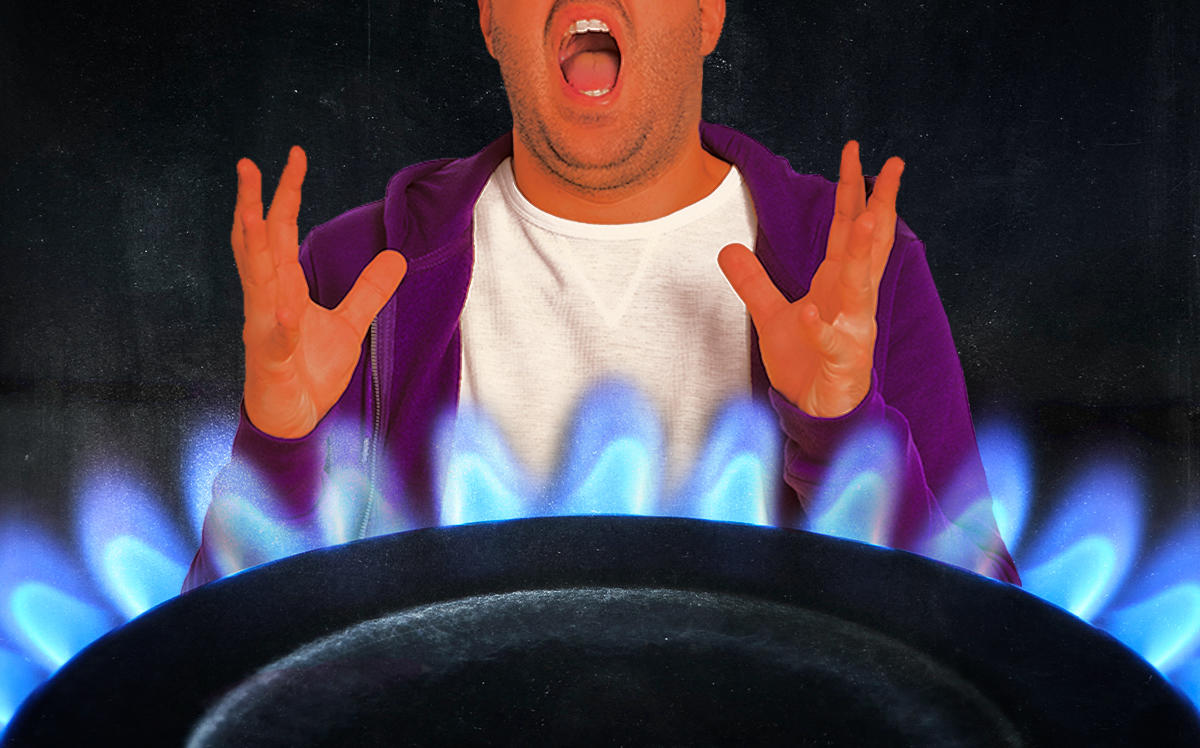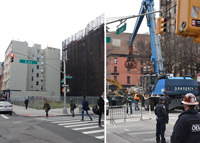
Trending
No gas in your apartment? Don’t hold your breath
Hot plate hell: Why service outages drag on for months

Graham Ciraulo was living in Inwood in 2016 when he received a notice from his landlord: the building’s cooking gas had to be shut off.
It didn’t say for how long. But weeks passed, then months, before tenants could use their stoves again.
“It was a seven-month outage in total,” said Ciraulo, who works as a tenant activist. “We were given hot plates, which, ridiculously, we were eventually charged for.”
By one measure, Ciraulo and others at 11 Seaman Avenue were lucky: At some buildings, tenants have gone without cooking gas for even longer. Property owners are required by law to keep apartments heated in winter, but no such guarantee exists for cooking gas.
Restoring gas service can get bogged down by communication issues and unclear standards between several agencies, according to interviews with more than a dozen people familiar with the process.
Read more



Virtually everyone involved in shutting and restoring service agreed that the responsibility ultimately falls to the landlord — in Ciraulo’s case, the Parkoff Organization, which did not respond to requests for comment. However, several also said the service provider — Con Edison or National Grid, depending on which part of the city it is — and agencies such as the Department of Buildings are disingenuous when they deny a role in prolonging outages.
Frank Ricci, director of government affairs for the Rent Stabilization Association, a landlord group, said the problem is substantial.
“This is driving people across the city crazy,” he said, “because it’s a major inconvenience for tenants, and tenants are getting mad at the owners about this — legitimately — because they want their gas back on.”
An explosive issue
Many observers believe delays in restoring service got worse after New York was rocked by a pair of fatal explosions. The first, in Harlem in 2014, killed eight people, injured more than 50 and leveled the buildings at 1644-1646 Park Avenue. Con Ed in 2017 agreed to a $153 million settlement with the state in that incident.
The second blast, in the East Village in 2015, killed two, injured 25 and destroyed buildings at 119, 121 and 123 Second Avenue.
Con Ed spokesman Allan Drury said the company increased its efforts to get people to report gas leaks after the Harlem explosion and that the city cracked down on illegal “Mickey Mouse jobs” on gas lines after the East Village tragedy.
In 2016 the city passed Local Law 152, which requires gas piping to be periodically inspected at least every five years. If a leak, illegal connection or other dangerous condition is found, the building owner must immediately correct it.
Council member Rafael Espinal, who represents Bushwick and East New York, spearheaded the bill, which he said was a response to the Harlem and East Village explosions.
“I found it to be surprising that buildings go through many inspections, and gas lines weren’t one of them,” he said.
Despite the suspicions, a lack of data makes it difficult to prove that the length or frequency of gas outages has increased since the fatal blasts.
Con Ed, which provides gas service in all of the Bronx and Manhattan and part of Queens, does not track the length of outages but has seen their number decline in recent years. In 2016 it dealt with outages in 3,531 buildings, then 3,005 the next year and 2,614 the following year. That number was on pace to decline further, to about 1,500, in 2019 as of late May.
National Grid, which serves Brooklyn, Staten Island and part of Queens, does not keep statistics on gas outages at buildings, according to Karen Young, a spokesperson for the utility. Neither does the city’s Department of Housing Preservation and Development. Fixing gas leaks or moving pipes requires an alteration permit from the Department of Buildings, but the agency cannot break out data from permits to show which ones involved gas.
Chany Rosen, an expediter who recently started her own company, Cavalry Associates, said the lack of statistics is one reason gas outages do not get enough attention.
“There is no way to see the data on that information on one site: not the Department of Buildings, not National Grid,” she said. “That’s bothersome. If somebody would be able to gather that information and be able to actually see all the numbers, that wouldn’t be acceptable to anybody.”
Referring to tenants dealing with gas outages, she added, “There’s no way for them all to come together and raise the point that something has to be done.”
Ricci echoed that, noting that all of the information his group gets is anecdotal. Outages appear to be increasing based on the number of phone calls the RSA gets, but data is still almost impossible to come by.
“That would be helpful to know. That does make sense to me,” he said. “I mean, you can’t solve a problem until you define the problem.”
The blame game
When gas went out around October 2016 at a Parkoff Organization building at 500 West 235th Street, the landlord made sure to blame the utility company.
Parkoff sent a notice to tenants saying they would receive hot plates while the gas was out and apologized “for any inconvenience that you may be experiencing during this period due to the disruption of gas services caused by Con Edison.”
“This form is to acknowledge your receipt for temporary use of the hot plate and that you will return it once gas is restored to your apartment,” the notice said. “You acknowledge that the disruption of gas service is not the fault of the landlord.”
Most parties involved with gas outages agree that responsibility for ending them is ultimately the landlord’s. But they differed on how big of a role others play.
Con Edison and the Department of Buildings fervently denied having any control over the length of outages, pinning the wait almost entirely on landlords.
From Con Edison’s perspective, dealing with outages is straightforward. Gas is turned off when someone detects a leak in house piping, at which point the owner needs to hire a plumber to make repairs, Drury said. The plumber then gets a certification of completion from the buildings department and shows it to Con Ed. The utility then sends gas through the building to see if the piping holds. If it does, the company resumes service.
“The question of how long the process takes is nearly entirely dependent on the building owner or landlord and the plumber/contractor,” Drury said. “They control the repair process, not us.”
The Department of Buildings struck a similar note. Gathfeny Sanders, director of Its LAA unit, which handles the permitting required to restore gas service, said the length of shutdowns has “nothing to do” with his agency. Assistant commissioner Lisa Amoia said the department’s role begins and ends with handling permit requests.
“Once the ball is in our court, we follow through with these issues expeditiously, all the way to inspection and authorization,” she said.
A decade ago, however, the president of the Masters Plumbers Council wrote that it could take up to five months to get a permit, making plumbers look bad and causing building owners to use unlicensed people to get the work done in a timely manner.
But Sanders said the city now issues emergency notifications much faster, making it easier for the agency to hand out same-day permits.
Plumbers often play a role in extending gas shutdowns, according to Amoia. She said they sometimes realize the job is more complicated than they thought, and building owners sometimes must hire a new plumber if the first one’s license or insurance expires.
“Sometimes work begins, and it’s halfway through, and the licensee sometimes leaves the job for many different reasons,” such as “a dispute between the licensee and the owner,” she said. The size of the building also has a lot to do with how long the work takes.
But the role of the Department of Buildings and utility companies in prolonged outages is not as limited as they claim, others said.
Ricci cited two utility company practices that can protract gas outages. Sometimes, to save effort, utilities shut off gas for an entire building even if only one line needs closing. That can result in the whole building needing to be reinspected. Second, utilities test pipes at pressures of 75 to 100 pounds per square inch when the normal pressure is three to five PSI, he said.
“If they can isolate a leak to a specific apartment or a specific part of the building, they should shut that down. They shouldn’t shut down the whole building,” Ricci said. “And if the pressure that normally goes through is under five pounds per square inch but they’re testing it close to 100, I don’t think that’s fair, either.”
Drury denied that Con Ed inspectors shut an entire building’s gas for simplicity’s sake, saying it is “not at all unusual” for them to turn service off to just part of a building. He said the pressure for integrity tests “is at levels that provide assurance the piping is in fact safe for gas to be turned back on.”
April McIver, executive director at the Plumbing Foundation, a nonprofit founded to help enact and enforce safe plumbing codes, said building owners are not in an enviable position.
“It’s not always that easy to get the gas turned back on,” she said, “because when you’re dealing with certain gas piping that involves both the utilities and the Department of Buildings, some things overlap, and they keep changing their policies on how they want the process to go.”
Terence O’Brien, senior director at the foundation, said part of the problem is stingy owners.
“They don’t want to pay the money to get [a licensed] plumber to come do the work and get things done quickly, properly and meticulously,” he said.
Landlord Lenny Katz said he has dealt with gas issues multiple times, including once at a building of his on East 22nd Street in Flatbush. He said the process is supposed to be simple, but coordination between the buildings department, the plumber and the utility company can make it difficult.
The subjectivity of inspectors can make things tough as well, he said.
“Very often, buildings inspectors have to come back multiple times,” he said. “You don’t always get the same inspector, so one inspector tells the plumber everything is fine except for A, B and C, and then when the next call for an inspector comes, it’s a different person, and they come down and say everything is fine except for C, D and E.”
Owners can also be required to fix violations that are found even if they are unrelated to the gas leak.
“DOB may require you to do a lot of work, and a lot of it has nothing to do with what was leaking,” Katz said. “But they want things brought up to the current code.”
The fact that a building owner cannot turn to another agency or utility can hinder progress as well, Katz said.
“You can’t call another gas company,” he said. “They work on their [own] schedule, so waiting for them to come, waiting for them to unlock the meter, to put in a new meter if you need it, can sometimes take a while.”
The Department of Buildings said in a statement that long gas outages are usually because the building owner or plumber does not act quickly. It disputed that varying standards from different city inspectors can play a role.
“An experienced licensed master plumber will know dangerous or illegal conditions when they see them and does not require DOB inspectors to point out these hazards,” the statement said. “If a plumber continues to make excuses about unforeseen issues and delays, we suggest hiring a new professional who has the time and experience to solve gas outages in a reasonable period of time.”
What’s a tenant to do?
With gas outages, the people who suffer the most have the least control over the situation: tenants. They have few options for recourse, according to real estate attorney Sam Himmelstein. Tenants can be entitled to rent abatements if their gas goes out, but generally not to escape their lease, he said.
“To break the lease, you’ve got to have something that almost results in what we call a constructive eviction,” he said, “like no heat in the winter or no hot water or really bad leaks or mold — things that are really making the apartment uninhabitable.”
Katz said that his company evaluates requests for rent relief during gas outages on a case-by-case basis. He maintained that there is not much landlords can do for tenants during these situations besides providing them with information and the customary hot plates.
“It’s tough to give an anticipated completion date because sometimes you really have no idea. You think it’s going to be a week, and it turns out to be another month,” he said. “You just try to keep them informed.”
Tenants with gas outages in rent-regulated apartments can file complaints with the state’s Division of Homes and Community Renewal. If the agency finds that the building owner has failed to maintain essential services, it can order a rent reduction.
Landlords occasionally use gas outages as a way to drive tenants out of rent-stabilized apartments, according to Aaron Carr of the Housing Rights Initiative. If the outage is the only issue at a building, it is probably not a case of harassment, but if it occurs in conjunction with other maintenance issues, a landlord may be using it as a pretext to persuade tenants to leave, Carr said.
“If you don’t have heat, and you don’t have gas, and you don’t have maintenance, that is an intolerable situation,” he said.
These are typical of the complaints that Espinal said his office receives about gas outages.
“In my district, it does take a long time for certain building owners to restore gas,” the council member said, “and the impression we get is that they are doing it with the hopes that it would push their tenants out.”
Ciraulo believed that was the case at his Inwood building, given how long it took Parkoff to get service restored.
“There was just a real dragging out with the gas,” he said. “They were just not interested in making it easier for us.”
Ciraulo said some tenants moved out during the outage and that Parkoff only fixed it when tenants moved to take legal action. The rent law has since been changed to remove landlords’ financial incentives to push tenants out.
O’Brien, of the Plumbing Foundation, maintained that the perception of lengthening service interruptions is inaccurate. Rather, they are being fixed more thoroughly, he said.
“People are thinking gas outages are lasting longer. They aren’t lasting longer,” he said. “It’s just things weren’t done properly, and now they’re being a little bit more scrutinized, so it’s being done now more correctly than in years past.”
Himmelstein disagreed, maintaining that lengthy outages have become much more common in the wake of the fatal Harlem and East Village explosions.
“A few years ago, they might have just said, ‘Patch up that hole,’” he said. “Now, they make them do much more extensive work, and it takes months. I’ve seen it take a year or two.”




